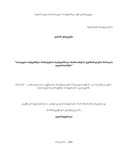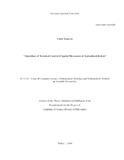Please use this identifier to cite or link to this item:
https://dspace.nplg.gov.ge/handle/1234/142954Full metadata record
| DC Field | Value | Language |
|---|---|---|
| dc.contributor.advisor | მილნიკოვი, ა. | - |
| dc.contributor.author | Erguven, Gabir | - |
| dc.date.accessioned | 2016-02-25T08:34:02Z | - |
| dc.date.available | 2016-02-25T08:34:02Z | - |
| dc.date.issued | 2006 | - |
| dc.identifier.uri | http://www.nplg.gov.ge/dspace/handle/1234/142954 | - |
| dc.description.tableofcontents | General Characterization of the Work–– Analysis of Literature Sources–– 1.1 Types of Robots–– 1.1.1 Robots in Agriculture–– 1.1.1.1 Fruit Picking Robot–– 1.1.1.2 Tomato and Cherry Tomato Harvesting Robot–– 1.1.1.3 Strawberry Harvesting Robots–– 1.1.1.4 Cucumber Harvesting Robot–– 1.1.1.5 Multi-Operation Robot for Grapevine–– 1.1.1.6 Chrysanthemum Cutting Sticking Robot–– 1.1.2 Stock Raising–– 1.1.2.1 Sheep Sheering Robot–– 1.1.3 Robots for the Food Industry–– 1.1.3.1 ––The Intelligent Integrated Belt Manipulator–– 1.1.3.2 Food Cutting Systems–– 1.1.3.3 Vision-Based Object Handling–– 1.2 Survey of Robot Manipulators Movement Control Methods–– 1.3 Differential Equations of Motion–– 1.4 Terminal Control Problems–– 1.5 Goals and Objectives of the Research Work–– 2. The Spinor Model of Spatial Rotation Kinematics–– 2.1 Spinor Representation of Generalized Three-Dimensional Rotations 33–– 2.2 Calculation of Euler Angles–– 2.3. Kinematics Expressions for Euler Angles–– 3. Problems of Terminal State Control for Controlled Objects–– 3.1. General–– 3.2. Reduction Problem; 3.2.1 Controlling Function Synthesis–– 3.2.2 Analysis of the Control Process Dynamics in the Reduction Problem–– 3.3 The Acceleration Problem–– 3.3.1 Controlling Function Synthesis–– 3.3.2 Analysis of the Control Process Dynamics in the Acceleration Problem–– 3.4 The Approach Problem–– 3.4.1 Controlling Function Synthesis–– 3.4.2 Analysis of the Control Process Dynamics in the Approach Problem–– 3.5 The Approach Problem with an Additional Condition Imposed on the Terminal Accelerations–– Control of Terminal States of Spatial Rotations of Robot-Manipulators–– 4.1 Control in the Initial Rotation Stage–– 4.2 Control in the Uniform Rotation Stage–– 4.3 Deceleration–– 4.4 Development of an Optimal Control of the Electric Drive of Spatial Rotations of Manipulators–– Conclusion–– References. | - |
| dc.format.extent | 104 გვ. | en_US |
| dc.language.iso | en | en_US |
| dc.language.iso | ka | en_US |
| dc.source | ''Algorithms of terminal control of spatial movements of agricultural robots''/ G.Erguven: Dis...Candidate of Science 05.13.16/ Supervisor: Doctor of Science, Professor Dr. Alexander Milnikov; Tbilisi - 2006-104p. Bibliografia: p99-104(საქართველოს პარლამენტის ეროვნული ბიბლიოთეკა, საარქივო ფონდი) | en_US |
| dc.subject | სოფლის მეურნეობა | en_US |
| dc.subject | რობოტ–მანიპულატორები | en_US |
| dc.subject | მოძრავი მექანიკური ობიექტები | en_US |
| dc.subject | კვლევის შედეგები | en_US |
| dc.title | ''Algorithms of terminal control of spatial movements of agricultural robots” | en_US |
| dc.type | Thesis | en_US |
| dc.type | Thesis | en_US |
| dc.rights.holder | საქართველოს პარლამენტის ეროვნული ბიბლიოთეკა | en_US |
| Appears in Collections: | ეროვნული ბიბლიოთეკის დისერტაციებისა და ავტორეფერატების ფონდი | |
Files in This Item:
| File | Description | Size | Format | |
|---|---|---|---|---|
| Disertacia.pdf | 1.16 MB | Adobe PDF |  View/Open | |
| Referat Georgian.pdf | 323.09 kB | Adobe PDF |  View/Open | |
| Referat_English.pdf | 279.65 kB | Adobe PDF |  View/Open |
Items in DSpace are protected by copyright, with all rights reserved, unless otherwise indicated.
